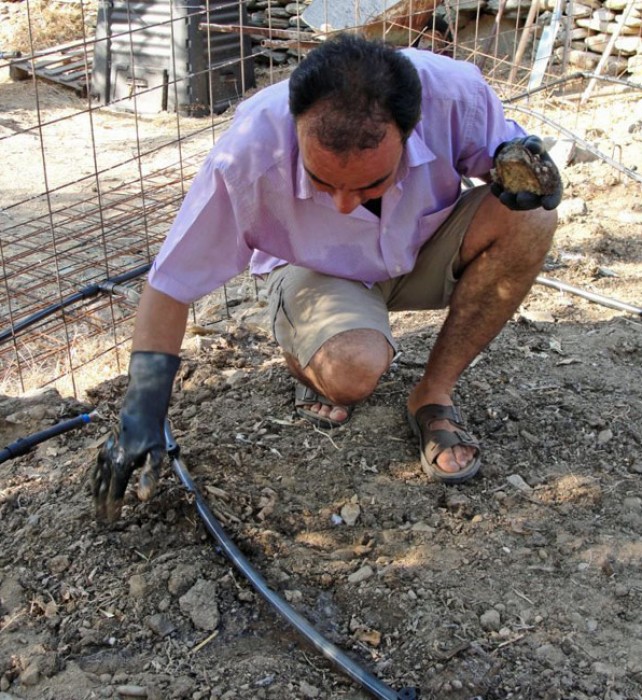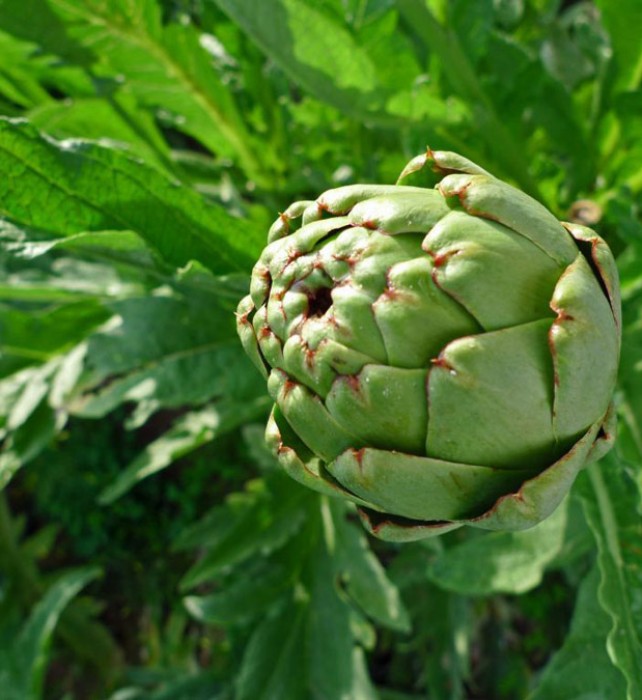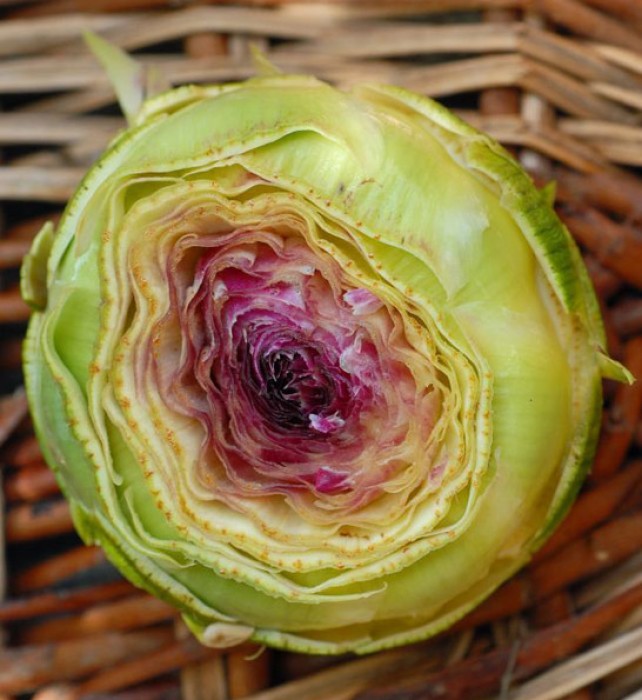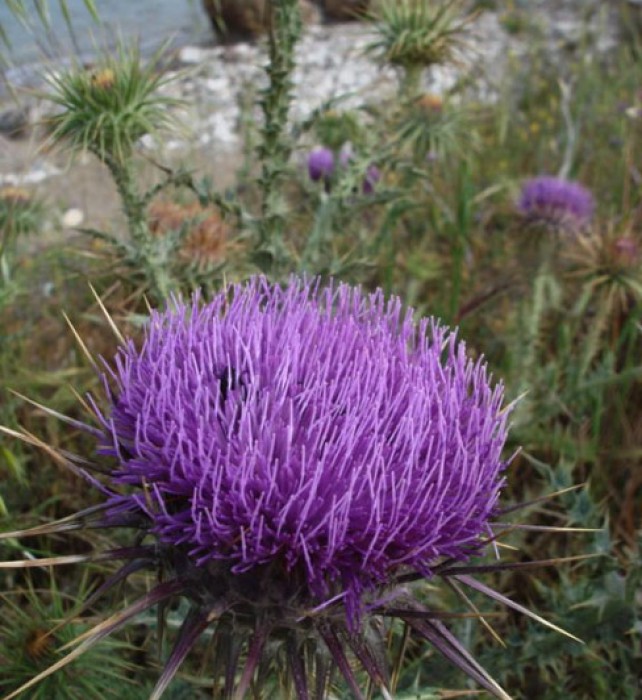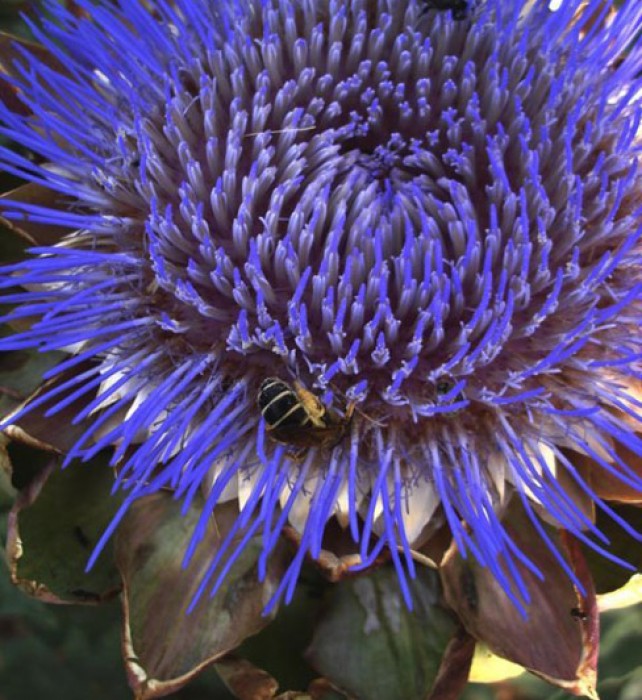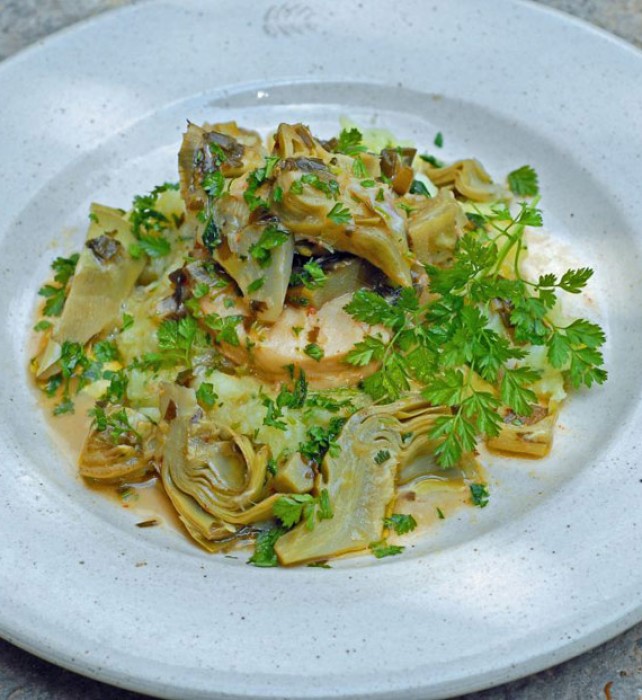Besides supplying us with their delicious edible buds, artichokes, if left to blossom, surprise you with their furry stunningly purple and huge flowers. First cousins to the ubiquitous Mediterranean thistle they look like medieval chevaliers, wrapped up in impenetrable green armor. Some artichokes have large spikes on the pointed edges of their leaves, but their sensitive hearts remain tender and vulnerable, juicy and crunchy.
Artichokes truly embody the essence of the Mediterranean: sentimental and sensual but at the same time hardy and a model of perseverance. They totally dry out in the summer, only to bud miraculously from the earth with the very first rains, their lush leaves emerging like artesian wells from the soil.
They grow very easily, or so you might be told. Artichokes don’t need much water, Greeks will tell you, neither do they require extra care; they simply take root, never to leave your garden. Unfortunately, not inour garden! We have been trying to grow them for years…
From my childhood I remember the stubborn artichokes that one spring morning pierced the porch floor in the house I grew up in Patissia, on the outskirts of Athens. Our home was built on my grandfather’s garden and was surrounded by verandas with thick concrete foundations that apparently proved no match for the old, sprouting artichokes. I told Costas the story the first year we moved to Kea, as we were trying to decide which plants to grow in our stony island garden. I was certain that artichokes would be an unqualified success.
Following the advice of Angelos, who owns the nursery, we planted a few young artichokes at the end of our first winter on the island. Most of them died slowly before spring, but a couple did grow a bit, giving us two slim artichokes. That was it; by summer they disappeared forever. We tried once more, the following year, with similar results; then we gave up.
Last spring, as I was researching my monthly magazine column, I called Vangelis Lykourentzos, an artichoke producer from the Peloponnese, where most of the Greek artichokes are grown. We spoke about his village’s upcoming artichoke feast, and I offered to help them to attract visitors. At some point I told him about our gardening misfortunes, and he was genuinely surprised: “We don’t plant artichokes in the winter,” he said, “you start with the tuber-like roots late in the summer. I will bring you some to Kea and help you plant them.” He explained that when both the oversized artichoke flowers and the leaves dry up in the summer, only then the plant’s root deepens in the soil, remaining fleshy and retaining its humidity. With the first winter rains, the leaves sprout, and after a few months you will start to have you own crop, Vangelis promised. Our previous failures, though, made such an outcome difficult to believe.
Early last September, during our Kea Artisanal program, Vangelis came to Kea with two overflowing artichoke-root cases. Costas had cleared a patch of land from the weeds and stones, added lots of manure, plowed it, and installed a drip system just as Vangelis had instructed. About four hours before planting the tuber-like artichoke roots we turned the water on – something that drove eco-friendly-Costas crazy, as he couldn’t bear spending so much water in September, when the island’s resources are at their lowest. The truth was that we were not convinced that something would really come out of this, our third artichoke venture. Vangelis showed us how to plant the roots, gently pushing each tuber into the ground, twisting it until “it finds its place in the soil,” as he said.
The amount of water we used on these plants until the rains started caused Costas’ hackles to rise in horror, but he was determined to follow Vangelis’ instructions to the letter. Even I started to protest, pleading to shorten the instructed watering time. But Costas, now totally invested, insisted that the newly planted artichokes needed watering until their roots deepened, and anyway this was our last chance, and although he knew it was probably not going to work, we should give the plants exactly what the expert had prescribed. Even Stathi, our usually optimistic neighbor, wasn’t at all sure about the outcome. He, like us, had failed more than once trying to plant artichokes from the nursery. When the first shoots appeared in November, we went through another period of constant anxiety, as the snails started to devour the tender leaves. Vangelis said we needed to dust the plants with a chemical to get rid of the slimy creatures, or else we might risk losing everything. Even eco-Costas agreed, unable to bear the thought of having wasted so much water. But I was adamant; we had planted more than enough, I said, and we had plenty of thriving artichokes to share with the hungry snails that turned most of the hearty leaves into fine filigree. Fortunately, they never reached the buds. With much intervening trepidation, we waited. Would April, as T.S. Eliot says in The Waste Land, prove the cruelest month? Not on this occasion. Come spring, our garden rewarded us with an abundance of wonderful artichokes, far exceeding our wildest dreams!
Crunchy and aromatic, not too large but so tender that you can eat leaves and not merely the heart, our first five artichokes made for a delicious risotto, enhanced with lemon, fragrant with our garden’s intensely aromatic parsley and wild fennel. More artichokes appear every day, and we can now feast on them at least twice a week, and still have more to offer to friends. Vangelis, ever confident, showed not a hint of surprise at our, and his, success. Costas is thrilled; Stathis still can’t believe it. As for me, I have to come up with yet more recipes to showcase our new, wonderful crop, not wasting any part of it, especially not the stems, which are crunchy and delicious when peeled. Following the steps of my ancestors, I feel part of the age-old culinary tradition, compelled to serve a new artichoke dish with each preparation, stuck as I am with our bounty. Fortunately, millions of women around the Mediterranean have been faced with a similar dilemma since antiquity, and so there is an endless cornucopia of artichoke dishes to choose from… SEE ALSO on The Atlantic.
RECIPES
Braised Veal with Artichokes in Egg and Lemon Sauce
Monkfish with Artichokes and Olive oil-Garlic Mashed Potatoes




